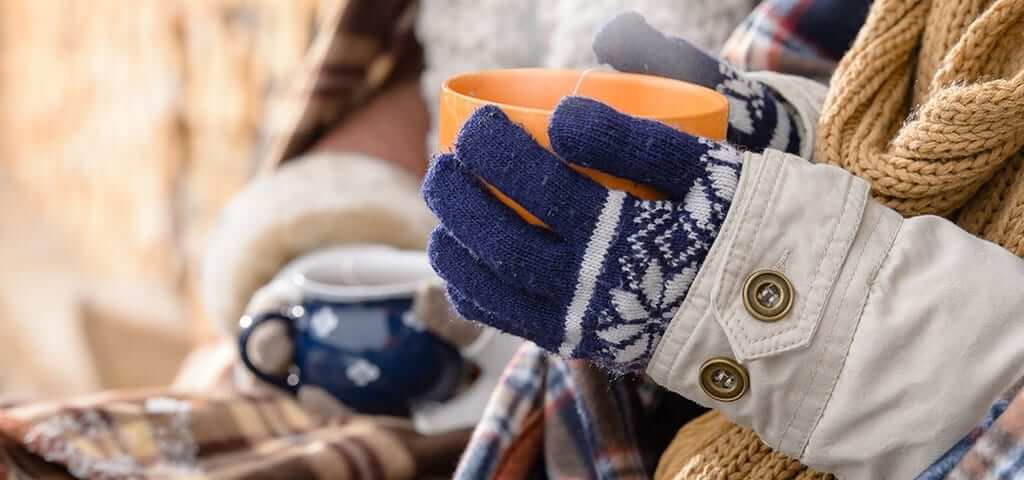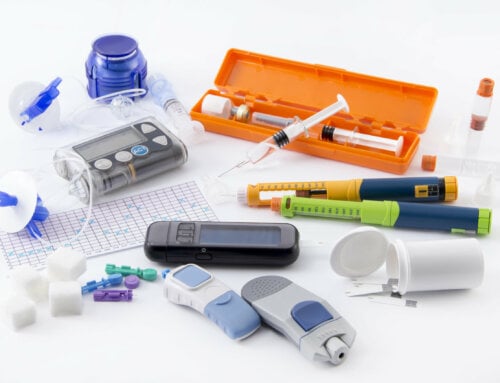Winter has arrived with huge amounts of snow fall in the West, Midwest and Northeast regions. The South, including Florida had temperatures in the 30’s. Caring for diabetes can be challenging enough, but winter conditions may make it even more difficult. More people are diagnosed with diabetes during the winter months with the majority of cases diagnosed between November-February. There are multiple theories about why this may occur often related to the Ice Age.
Here are 15 specific points which can help you get through the winter season with ease.
- Dry sinuses, cracked lips, itchy eyes and bloody noses. During the winter months the humidity tends to be lower. Dry indoor heated air is difficult to handle but more of an issue when you have diabetes and dry skin. Humidifiers placed in the bedroom can be a lifesaver to help with dry air. They can be used daily or specifically when you have a cold, flu, allergy or respiratory problem. Humidifiers come in several types so do your research to recognize which one will work best for you. Some homes are actually built with central humidifier systems as part of the heating/cooling system. There are steam (may be dangerous and cause fires or burns), evaporator, ultrasonic or impeller humidifiers which aid water vapor back into the air. The best indoor humidity range is between 30-50%. Humidifiers are available in drugstores, big box stores as well as online. It is extremely important to properly maintain the humidifier to avoid growth of bacteria, fungi and mold. The bacteria and mold get trapped in the mist that is released into the air. This could cause another lung infection in addition to what you already have. Always follow manufacturers cleaning and maintenance instructions and use distilled water. Tap water contains minerals which can be breathed in through the mist. Change the distilled water often and completely dry out the unit prior to refilling. Change the filters regularly as suggested by the manufacturer. You may still need to replace humidifiers yearly since they accumulate minerals and deposits that become difficult to remove over time.
- Moisturize and skin protection. As with lips and nasal membranes, dry skin can crack anywhere, let in bacteria and cause an infection. After bathing or showering apply a white non-fragranced moisturizer on your entire body except between the toes (may cause fungus) while the skin is still moist. This allows for great absorption. Use creams and ointments during the winter months since they are thicker than lotions. Use lip balm and eye drops to keep these membranes moist as well.
- Eat chicken soup. It is not the chicken but the steam and liquid which may help open nasal passages and soothe a sore throat. A homemade soup can taste delicious on a chilly day and keep you satiated. Keep a large container of frozen soup which can be ready to go quickly. Winter ailments including a fever can dehydrate and eating soup can be a remedy for rehydration. Include a protein such as shrimp, lean beef or chicken, lots of cut up vegetables, fresh herbs and wild rice or quinoa to a low sodium broth and you have a complete, easy meal. Use carrots, onions, cabbage, tomatoes and broccoli for added fiber, lycopene and indoles to boost your immunity. Add antioxidant spices including garlic, turmeric, black or cayenne pepper for more flavor and health benefits.
- Get a flu shot. It is still not too late to get a flu shot since flu season runs thru March. So far this year, outbreaks have been mild but as the winter continues U.S. health officials say “they are certain to see a jump in cases”. With diabetes, you are more at risk for illness and need the added protection from the shot. Stress from the illness can also raise blood sugars. Each individual should check with their health care provider to see if they need a flu shot. According to the CDC “Flu complications including pneumonia and bronchitis send 200,000 Americans to the hospital each year and over 49,000 deaths are attributed to the flu in a typical year”.
- Stay hydrated. Drink enough sugar-free and zero-calorie fluids in the winter months even though you perspire less. Fluids may help with stuffiness and congestion. Herbal tea is a perfect option for relaxation too. Avoid alcohol and caffeine which increases dehydration.
- Make a sick day box. Many people who live alone are caught off guard when they get sick and do not have the right supplies in the house. Put together a sick day box including a thermometer, nasal saline drops, eye drops, sugar-free throat lozenges or throat spray that contains a numbing agent. Have Tylenol, Advil or regular aspirin as a fever reduction agent. Buy OTC sugar-free cough, cold and mucus remedies that do not raise blood pressure. Have an OTC product for stomach ailments including indigestion and diarrhea. Freeze Crystal Light into ice cubes to use for rehydration. Have sugar-free Jell-O on hand as well. Try a homemade diluted salt water gargle using 1/2 tsp of table salt with 8 ounces of water and rinse for a scratchy throat. Use nasal strips to help open nasal passages with no side effects. Keep glucose tablets and apple juice in case you can’t eat any carbohydrates to prevent hypoglycemia. Make sure you have extra testing supplies since your blood sugar may elevate during times of sickness. Always check with your doctor prior to using OTC products to make sure they are beneficial for you.
- Think about Zinc supplements. There is conflicting information about zinc supplementation but after review of most studies “zinc lozenges reduced the average length of a cold when taken within 24 hours of the onset of symptoms”. Always check with your health care provider prior to starting supplements to make sure they are right for you. Too much zinc can cause GI distress including a bad taste in the mouth. Be cautious about the zinc nasal swabs which have been known to change the sensitivity of smell.
- Vitamin C supplements. Vitamin C may also shorten the symptoms if taken early. Each person may get different results with supplementation so be aware.
- Wash your hands correctly and often. Hand washing on a regular basis is the number one way to help reduce illness from colds, viruses, bacteria and flu. When possible use regular soap and water and wash for at least 20 seconds. Wash every hand surface and between the fingers. If a sink is not available, use hand sanitizer with the highest content of alcohol. These products dry out skin and don’t remove visible dirt.
- Mind your feet. In the inclement weather, wear well-fitting, waterproof shoes or boots during the winter months. Make sure to wear diabetic socks for added protection. Dry your feet immediately when they get wet to prevent skin breakdown. Check feet daily for open wounds, corns, blisters, fungus, athlete’s foot, pain, numbness, red or hot spots. Report changes or problems to your physician or podiatrist as soon as possible.
- Keep testing supplies and insulin safe. Blood glucose testing strips and meters can be harmed by extreme cold or freezing temperatures. Do not leave supplies in the car and use control solution with the first strip of each new box to assure accurate results. Make sure insulin vials and pens are not allowed to freeze. This will change the consistency and degrade the insulin. Do not allow your insulin pump, CGM (continuous glucose monitor) or glucagon kit to freeze. Don’t test when your hands are cold. It will be more difficult to obtain a drop of blood. Wash hands with soap and warm water for a more accurate result. Wear gloves when outdoors and add hand warmers when temperatures are frigid.
- Avoid overeating. It is easy to pack on the pounds when you are wearing extra layers and sweaters; it is not easy to recognize the weight gain. Stay focused on your usual healthy eating with small portions and snacks to prevent hunger. Eat high fiber with vegetables and modest amounts of fruit and whole grains. Include lean protein. There is always another holiday celebration so partake in moderation. This way the weight will not creep up on you and be a big surprise in the spring.
- Stay active. It is simple to skip your walk when it is cold, raining, snowing or dark early. Keep moving even if you have to join a gym, community center or the YMCA. Drive to a store or mall. Use exercise videos, active video games or get a treadmill or exercise bike. Join a series of classes for a reduced price. Invest in a yoga mat and learn the positions at home. Play indoor games that require you to move. Take the stairs when you can. Buy a medicine ball or kettle bells – anything which will keep you moving helps with blood sugars and winter weight gain.
- Watch out for depression. With shorter days and less sunlight people often find themselves more depressed. It may be raining, drizzling or snowing for days on end. Watch out for “Cabin Fever” which is being stuck inside for long periods of time. Depression may make you stop taking care of yourself and your diabetes. Join a diabetes forum or chat group online to get support without leaving home. Visit with friends and neighbors if you feel isolated and alone. If you are sad for a day or two there is no problem, but if you suffer from sadness for more than two weeks, get professional help. Symptoms of depression include hopelessness, irritability, guilt, anxiety, decreased energy, helplessness, lack of joy, difficulty sleeping or staying awake and a change in appetite.
- Shoveling snow. Many people with diabetes also suffer from heart disease and should check with their physician prior to shoveling snow. If you are able to shovel, start with a layer of salt before the snow begins. This will help reduce the standing snow. Shovel as the snow accumulates to 2-3 inches instead of waiting until the storm is over. Use a sturdy metal shovel with a scoop shape which will make your work easier than using a plastic shovel.
Winter months and colder weather can be difficult if you do not plan ahead especially when you have diabetes.
Keep this list to stay safe and prepared!
NOTE: Consult your Doctor first to make sure my recommendations fit your special health needs.







Leave A Comment